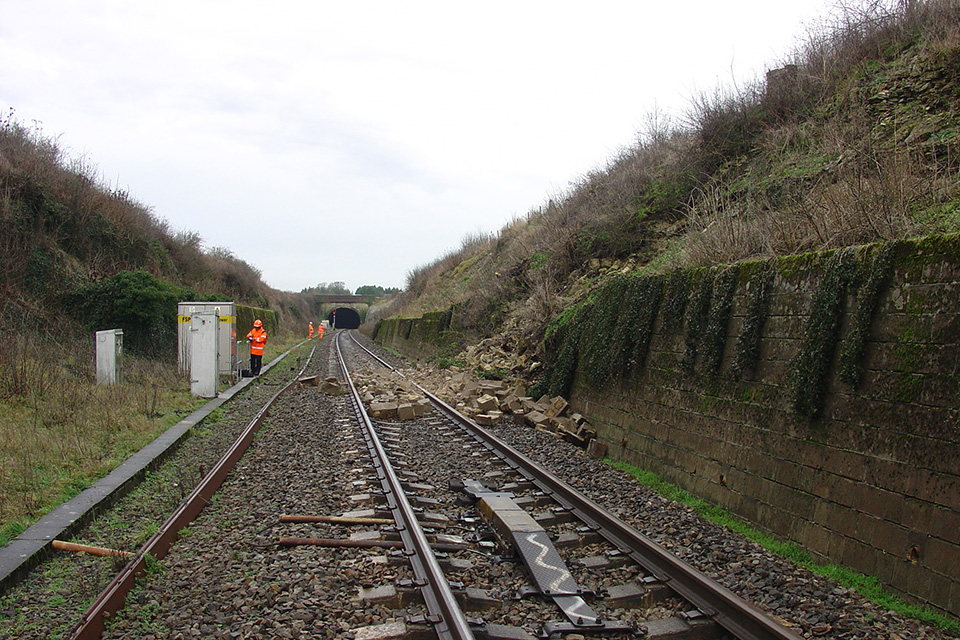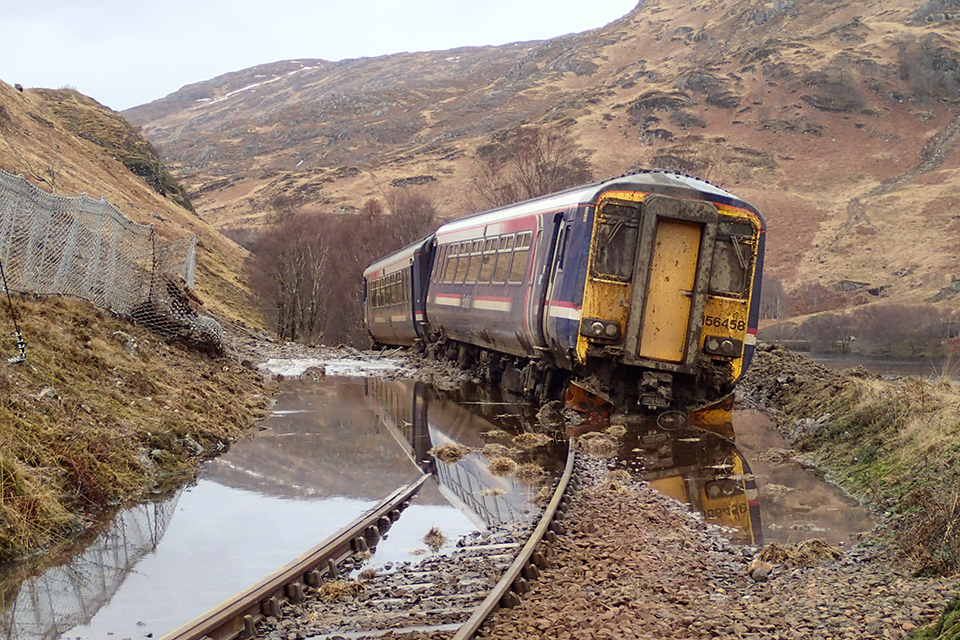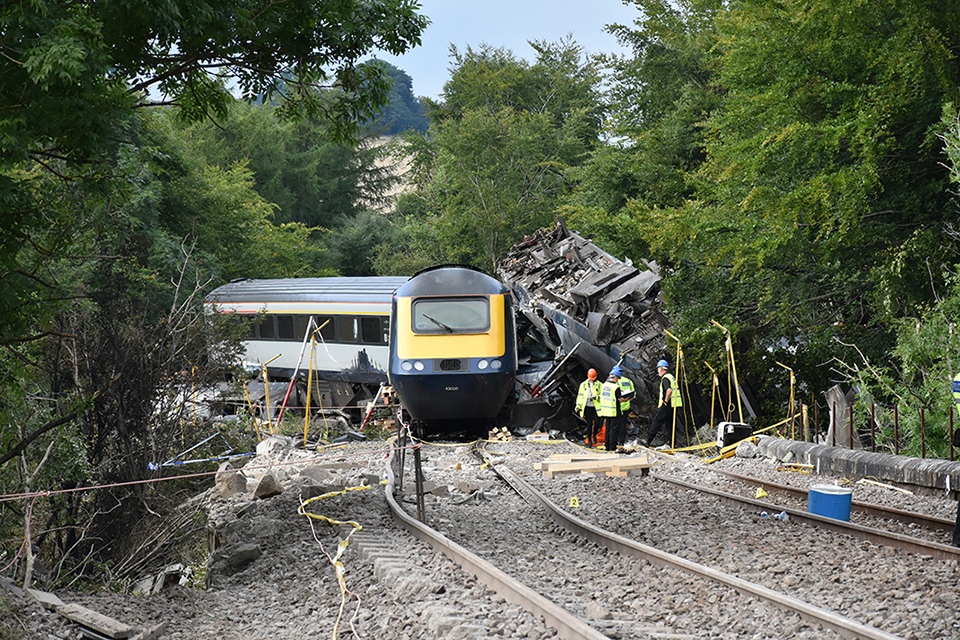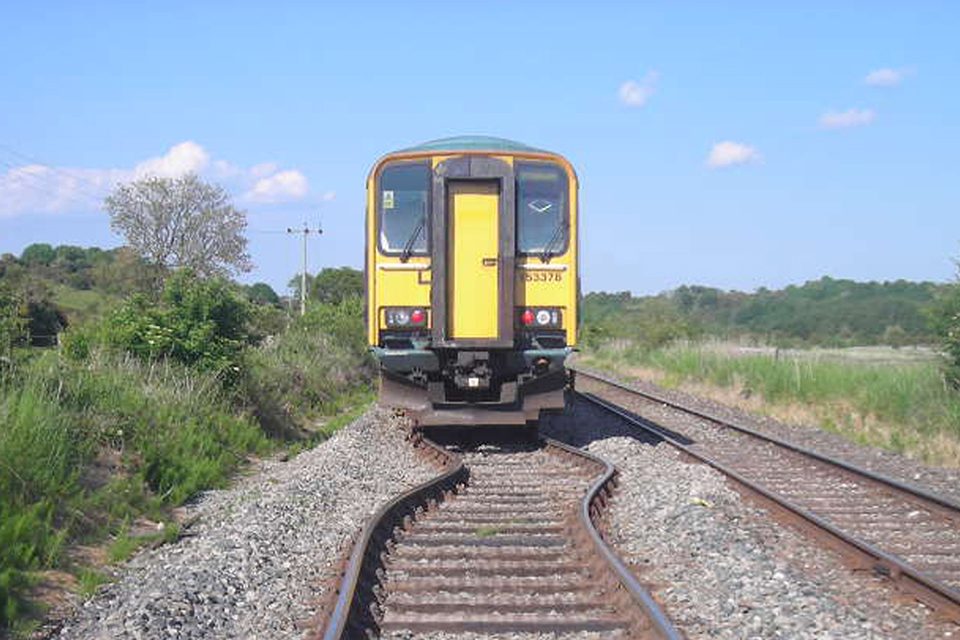Summary of learning - 7. The safe management of weather-related events which affect train operation - v5. May 2025
Published 21 April 2021
1. Purpose of this summary
The purpose of this document is to provide a repository of some of the most important areas of learning identified in RAIB’s investigations to date, cross-referenced to relevant reports. It therefore provides a reference source for those looking to understand real-world railway safety issues and potential control measures.
When preparing this document, RAIB has selected those issues which:
- have recurred in different RAIB investigations
- have still to be fully addressed
- could be a factor in the cause of a fatal accident
RAIB is aware that many of the issues raised have already been the subject of actions by duty holders when responding to RAIB recommendations, or are in the process of being addressed. The inclusion of a topic in this document should not be taken to mean that no action has been taken in response to relevant recommendations. However, its inclusion indicates that RAIB is of the view that the issue still needs to be actively managed by duty holders.
The current status of each recommendation made by RAIB can be checked by reference to the Index of RAIB recommendations, and details of the actions taken are published by ORR.
It is not the purpose of this document to quantify the risk associated with each of the identified safety issues. Readers seeking to understand the overall risk of harm associated with various dangerous events should refer to RSSB’s Annual Safety Performance Report. This presents historical information on actual harm caused, and estimates of risk based on extensive modelling.
2. Overview
The weather can affect the railways in many different ways. While some events may result in no more than inconvenience, as when speed restrictions are imposed in hot or windy weather, there can be more serious consequences. Most of Britain’s railway infrastructure dates from the nineteenth century. The Victorian railways were mainly designed and built without the benefit of scientific research, and before modern standards for civil engineering construction were promulgated. Historically, there have been many accidents associated with weather conditions: while the collapse of the Tay Bridge in 1879, with the loss of 74 lives, occurred in a storm, its main cause was the inadequate design, construction and maintenance of the bridge.
More recently, the collapse of Glanrhyd Bridge, near Llandeilo, in 1987, occurred because of an abnormally severe flood. A train ran onto the damaged bridge, and four people were killed. This accident led to changes in the railway’s approach to the management of structures. Since then, we have seen examples in recent years of floods, washouts, landslips and collapses of earthworks and structures. Some of these have involved trains, most recently at Carmont, Aberdeenshire, in August 2020 when three people died after a passenger train collided with material washed out of a drain descending a cutting slope.
There is a clear need for the railway industry to manage its infrastructure effectively, both to minimise the risk of damage occurring, and to mitigate the consequences of weather events, be they ‘normal’ or extreme. An increase in the frequency and severity of extreme weather events, associated with climate change, makes this one of the most important safety issues facing today’s railway.
3. Important areas for safety learning
The areas of significant concern to RAIB fall into the four main themes described below.
3.1 Management of earthworks and structures
Following RAIB investigations of derailments at Oubeck (report 19/2006) and Moy (report 22/2006) in November 2005, and at Kemble in January 2007 (report 07/2008), which seemed to have some features in common, RAIB carried out a class investigation during 2008 into Network Rail’s management of earthworks (report 25/2008). This found that, while Network Rail’s approach to earthworks management was comparable to or better than other industries with similar earthworks, the practical understanding of climate change and its effect on railway infrastructure was limited, and there was inconsistency in the application of earthworks management systems across Network Rail. We recommended that Network Rail should take various actions to improve its knowledge of its assets and its performance in managing them.
Since then, subsequent investigations have found that Network Rail has put a lot of effort into improving its performance in this area, but the stress put on the infrastructure from weather events has also increased. RAIB has also investigated incidents in which structural failure has occurred as a result of deterioration over time, rather than extreme weather events. These are not discussed further in this document, but they reinforce the need for an effective system for managing the condition of structures.

Collapsed wall following landslip at Kemble.
Accidents related to earthworks may involve landslips or washouts. In both cases a risk of derailment is created, as trains may run into debris, as at Gillingham tunnel in 2009 (report 19/2010), Watford tunnel in 2016 (report 11/2017) and Corby in 2019 (report 04/2020), or onto inadequately supported track, as at Knockmore in 2012 (report 14/2013) , Baildon in 2016 (report 03/2017) and Haddiscoe in 2022 (report 07/2023).

Derailed train following landslip at Loch Eilt.
Structural failures are often related to the effects of heavy rain, either by itself, as at Dryclough Junction in 2011 (report 17/2011) and Loch Eilt in 2018 (report 10/2018) or as the cause of floods as at Lamington in 2015 (report 22/2016) when larger than normal water flows create additional scour risk around the supports of bridges. Responding to these pressures may require the railway to work with owners of adjacent land to ensure that drains are adequate to deal with the flows of water, and to recognise when changes in land use will result in additional water flow onto the railway. The data and analysis needed to prompt such work is not always available.
3.2 Response to adverse weather
The safety of trains can be affected by extreme weather events, which are forecast some time before they occur. The response of the railway to weather forecasts has been explored in several investigations. Six events which occurred between June 2012 and February 2013 led us to undertake another class investigation, which reported in December 2014 (report 08/2014) and concentrated on earthwork issues related to effects from neighbouring land and response to unusual weather conditions. It found that in several instances, trains were being operated without special precautions when there was a significant risk of encountering a landslip. We recommended that Network Rail should review and improve its processes for managing earthwork-related risk arising from neighbouring land, and also improve its processes for collecting information about imminent adverse weather and responding to such reports.
Subsequent investigations have found progress in these areas, but the recent accident at Carmont shows that there were still gaps in the railway’s preparedness. When bad weather is forecast for, or already occurring in, a specific area, it may be necessary to close lines, or to reduce the speed of trains to mitigate the consequences of collisions or derailments. The decision to initiate such measures must be actively taken, informed by adequate data and in accordance with sound evidence-based criteria and established processes. To manage the operational risk, Network Rail uses processes including the extreme weather action teleconference (EWAT). This is used to plan the railway’s response to forecasts of severe weather, but our investigation of the Watford tunnel accident (report 11/2017) found that it is less effective for summer storms which can be very intense and localised.

Train following derailment at Carmont.
At around 09:37 on Wednesday 12 August 2020, a passenger train derailed near Carmont, Aberdeenshire (report 02/2022). The train, reporting number 1T08, was the 06:38 service from Aberdeen to Glasgow, which was returning towards Aberdeen due to a blockage that had been reported on the line ahead. It was travelling at 73 mph (117 km/h), just under the normal speed for the line concerned. After derailing, the train deviated to the left, before striking a bridge parapet which caused the vehicles to scatter. Tragically, three people died as a result of the accident and the remaining six people on the train were injured.
The Carmont derailment resulted from gravel being washed out from a drainage trench, onto the track below, during intense rainfall. RAIB’s investigation found that route controllers did not have the information, procedures or training that they needed to effectively manage a widespread and potentially dangerous weather event of this type. Consequently, no instruction was given to train 1T08 to reduce its speed on its return journey north. RAIB also found that, before this derailment, Network Rail’s approach to the management of risk to its infrastructure from extreme rainfall was primarily focused on those assets known to be at risk. There were no standard procedures in place to address the more general risk to assets during the most severe type of storms.
Modern weather forecasting and monitoring systems can spot truly exceptional events before they occur and as they happen, so allowing railway operators to implement precautionary measures when it is prudent to do so. This would benefit the safety of the line (by restricting train speeds, or suspending operations, when necessary) while reducing the need for imposing blanket speed restrictions over areas that are not at significant risk. RAIB has recommended improved operational responses to extreme rainfall events, exploiting the full capability of modern technology, and based on a detailed understanding of the risk associated with extreme rainfall. It has also recommended improved training for operational decision-makers so as to enhance their capability to respond to this type of event.
At about 23:13 on Friday 26 November 2021, an empty passenger train collided with part of a fallen tree near Balderton in Cheshire, while travelling at 46 mph (74 km/h). RAIB found that Network Rail had not factored in all relevant meteorological data when applying weather-related mitigation on the night of the accident (safety digest 03/2022).
On 14 July 2023, Network Rail issued blanket speed restrictions in anticipation of heavy rainfall, which had been forecast for 2 days across Scotland. The following day a number of trains approached a blanket speed restriction between Blackford and Gleneagles, unaware that they were required to reduce their speed to 40 mph (64 km/h) instead of the normal maximum permitted speed of 90 mph (145 km/h). Two of these trains passed through the speed restriction area without reducing their speed. These overspeeding incidents occurred because information on the blanket speed restriction had not been effectively communicated to the drivers (safety digest 06/2023).
3.3 Snow and ice

Wagons following derailment at Carrbridge.
Winter weather can bring particular hazards to the railway. While ice and snow are recognised as disruptive, it is possible for them to create significant safety risks. RAIB’s investigations into an incident at Carstairs (report 02/2011) and an accident at Carrbridge (report 03/2011), which both occurred in Scotland during the winter of 2009-10, found that a build-up of snow on rail vehicles, occurring during a journey, could lead to impaired braking performance affecting the trains’ ability to stop safely. As well as changes to the operating rules to improve the effectiveness of brake tests carried out by train drivers, there was also a need for the extreme weather actions described above to include measures to deal with risks from wintry weather.
Failure to implement a strategy for risk mitigation in wintry weather was also a factor in the accident in Summit tunnel, West Yorkshire, in 2010 (report 16/2011), when a train derailed after hitting a pile of ice which had fallen onto the track. When train operations are disrupted by adverse weather conditions, the situation needs to be properly managed. Our Summary of Learning number 4 covers the management of abnormal train operating events.

Ice found below a ventilation shaft after the derailment at Summit tunnel (courtesy of British Transport Police).
3.4 Heat
As the temperature rises and falls, rails expand and contract. Railway track is designed and constructed to cater for this, but in hot weather instability in the track support, and/or a restriction on the ability of rails to move longitudinally, can create conditions in which the track moves laterally (known as buckling), possibly immediately before or during the passage of a train. RAIB has investigated derailments caused by buckling, at Cummersdale, Cumbria in 2009 (report 06/2010) and at Langworth, Lincolnshire in 2015 (report 11/2016). These investigations highlighted the importance of good maintenance practice, and the need for clarity in the Rules relating to trains passing over sections of track where defects have been reported.

Severe track buckle at Cummersdale.
In July 2022, the UK experienced an extreme heatwave across much of the country, with Met Office reports showing temperatures exceeding 35°C across England and parts of Wales. Rail services were severely disrupted by these high temperatures. During this period, Network Rail imposed blanket emergency speed restrictions (a precautionary speed restriction that is imposed over a wide area without the installation of lineside warning signs) on many of its lines.
RAIB found that a number of overspeeding incidents occurred during the period in which these blanket emergency speed restrictions were in force (safety digest 06/2022). These incidents highlighted the need to use appropriate methods, including available technology, to make sure that safety-critical messages such as weather-related speed restrictions reach the staff who need to receive and act upon them.
On 11 and 12 June 2023 a number of trains did not observe heat-related emergency speed restrictions which had been imposed at Wood Green in London and Melton Lane level crossing in East Yorkshire. These overspeeding incidents occurred because the drivers of the trains involved did not realise that the emergency speed restrictions applied to their trains. In both cases, equipment already installed on the track which related to earlier speed restrictions had been adapted to warn drivers about the heat-related emergency speed restrictions (safety digest 05/2023).
4. Rail industry’s strategic safety groups
Cross-industry collaboration on matters related to infrastructure asset risk is driven by the Asset Integrity Group (AIG). Other relevant groups include the Train Accident Risk Group (TARG).
Following the derailment at Carmont in August 2020, Network Rail established two task forces to advise on ways of improving the management of climate risk to its infrastructure. The first of these, led by Dame Julia Slingo FRS, former chief scientist at the Met Office, was tasked with better equipping Network Rail to understand the risk of rainfall to its infrastructure, drawing on the latest scientific developments in monitoring, real-time observations and weather forecasting. The second, led by Lord Robert Mair CBE FREng FRS, considered how Network Rail can improve the management of earthworks. The final report from this task force was published in February 2021. This report made five ‘major recommendations’ aimed at improving Network Rail’s capability to predict and understand weather events.
5. Relevant RAIB publications
-
Derailment at Oubeck, Lancashire, 4 November 2005 (report 19/2006)
-
Derailment near Moy, Inverness-shire, 26 November 2005 (report 22/2006)
-
Derailment near Kemble, Gloucestershire, 15 January 2007 (report 07/2008)
-
Network Rail’s management of existing earthworks (report 25/2008)
-
Derailment near Cummersdale, Cumbria, 1 June 2009 (report 06/2010)
-
Derailment near Gillingham tunnel, Dorset, 28 November 2009 (report 19/2010)
-
Near miss involving a freight train and two passenger trains, Carstairs, South Lanarkshire, 22 December 2009 (report 02/2011)
-
Derailment of a freight train at Carrbridge, Badenoch & Strathspey, 4 January 2010 (report 03/2011)
-
Derailment in Summit tunnel, West Yorkshire, 28 December 2010 (report 16/2011)
-
Derailment near Dryclough Junction, Halifax, 5 February 2011 (report 17/2011)
-
Train ran onto a washed-out embankment near Knockmore, County Antrim, 28 June 2012 (report 14/2013)
-
Class investigation into landslips affecting Network Rail infrastructure between June 2012 and February 2013 (report 08/2014)
-
Derailment at Langworth, Lincolnshire, 30 June 2015 (report 11/2016)
-
Structural failure caused by scour at Lamington viaduct, South Lanarkshire, 31 December 2015 (report 22/2016)
-
Trains passed over washed out track at Baildon, West Yorkshire, 7 June 2016 (report 03/2017)
-
Derailment and subsequent collision at Watford tunnel, Hertfordshire 16 September 2016 (report 11/2017)
-
Landslip and derailment at Loch Eilt, north-west Scotland, 22 January 2018 (report 10/2018)
-
Train collision with material washed out from a cutting slope, Corby, Northants, 13 June 2019 (report 04/2020)
-
Derailment at Carmont, Aberdeenshire, 12 August 2020 (report 02/2022)
-
Train collision with fallen tree and derailment near Balderton, Cheshire, 26 November 2021 (safety digest 03/2022)
-
Overspeeds in weather-related blanket emergency speed restrictions 18-19 July 2022 (safety digest 06/2022)
-
Embankment washout under a passenger train at Haddiscoe, Norfolk, 30 January 2022 (report 07/2023)
-
Overspeeding incidents at Wood Green, and Melton Lane level crossing, 11 and 12 June 2023 (safety digest 05/2023).
-
Trains overspeeding between Blackford and Gleneagles, Perth and Kinross, 15 July 2023 (safety digest 06/2023)

